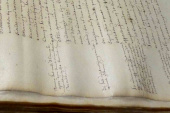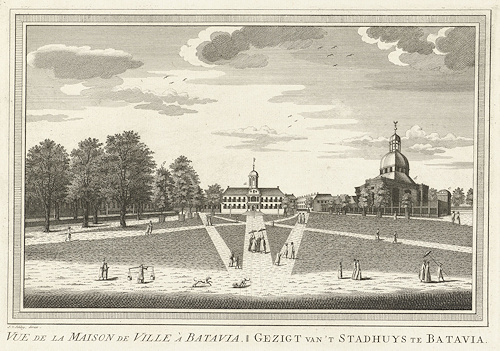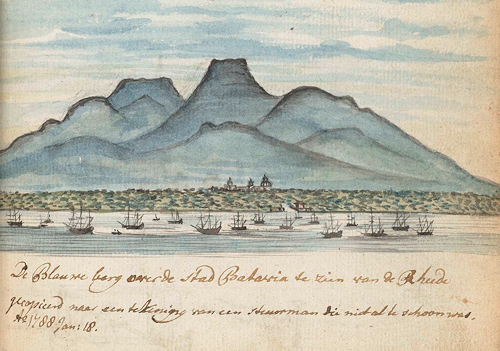Daily Journals of Batavia Castle 1624-1806

The Daily Journals of Batavia Castle are one of the richest and most concise sources for both the history of the Indonesian archipelago, and the wider Southeast Asian region. Covering a period of 184 years, the journals offer systematic data that cannot be found anywhere else on European and Asian shipping, European-Asian trade, Intra-Asian trade and Inter-Insular trade. They also refer – on a daily basis - to incoming and outgoing letters which number in their thousands over the period of the archive. Sometimes a brief summary of the content of these letters is given. One of the most significant features of the daily journals for historians is the insertion of more than two thousand diplomatic letters from Southeast Asian rulers to the Supreme Government in Batavia Castle, and the Supreme Government’s replies.

The Daily Journals of Batavia Castle are ‘journals’ in the sense that they are a daily record of incoming and outgoing letters, incoming and departing ships, local and regional events and occurrences, and financial business. These include the annual financial reports of Batavia’s local institutions. During the Nusantara's Golden Age of Commerce in the seventeenth century, the daily journals deal extensively with all kinds of trading and shipping activities throughout the region, including those far-flung activities of the VOC itself. During the 18th century the focus of these journals is more local reflecting the Company’s primary concern in this century for its local trade in the Java Sea Region and Sumatra.
The daily journals were created at the General Secretariat in Batavia Castle. That does not mean the that the daily journals are primarily recording events that occurred in Batavia. In fact, they tell us a great deal about the daily administration of the VOC’s headquarters and the Company’s concerns in Asia at large. Every day the duty clerk selected information from all the letters and oral reports forwarded to the Company’s central office. During the seventeenth century these covered general matters, the arrival and departure of European, Indonesian and Chinese ships, news from other Company establishments, reports from the incoming letters from Banten (West Java), Tanjungpura, Cirebon and other places on the north coast of Java, letters to and from Asian kings, princes and local regents. The Daily Journals of Batavia Castle refer to literally thousands of incoming and outgoing letters. Hence, the Daily Journals are principally books in which letters and short letter summaries were registered. They were not intended to be a written chronicle of events in Batavia in the first place, as the title suggests; hence we have chosen to follow the original title the ‘Daily Journals of Batavia Castle' (Daghregisters van het Kasteel Batavia) to reflect the fact that the archive reflects the Company’s wider regional concerns.
The daily journals from the seventeenth century were principally created to register the main political advisories and news reports from the VOC’s establishments in Asia. In 1642, Governor-General Anthonio van Diemen (1636-1645) even decided that members of the Council of the Indies should personally select relevant information about the particular Asian region they were responsible for. Hence, seventeenth-century Daily Journals contain information about a variety of Southeast Asian kingdoms such as Aceh, Pegu, Arakan, Tonkin, Siam, Perak, Kedah, Ligor, Melaka to name just a few. These provide information that becomes much scarcer in the eighteenth century when the VOC’s when the VOC’s focus became more local to Java (the coffee cultivation in Priangan) and Sumatra.

That said, even in the seventeenth century, information about the Indian regions of Bengal, Cormandel, Malabar and Gujarat is very scarce. It is the same with Persia and the Arabian countries. China and Japan are also dealt with only in general terms, although the earliest volumes contain valuable information about the relationship with China and the VOC’s successfull attempts to establish a trading post or factory on the island of Formosa (Taiwan) in the early seventeenth century. These priorities reflect the fact that Company officials in regional posts were creating their own daily journals on location. This was in accord with an instruction given by the Gentlemen 17 (HEEREN XVII) in the Dutch Republic to the Supreme Government in Batavia that such journals of local occurrences should be held in all VOC establishments in Asia. The keeping of such journals, beginning in 1621, may be seen as an extension of the practise of writing up ship’s journals at sea.
The originals of the earliest Daily Journals of Batavia Castle are kept in the National Archives at The Hague (1624-1629, 1631-1632, 1634-1636, 1647-1648, 1656-1657 and 1766). The former colonial archive or Landsarchief in Batavia kept 131 volumes, each volume covering a single year. A number of these volumes were seperated into two during a restoration project in 1978 – 1982 initiated by the former Director of ANRI, Dra Soemartini (in office 1972-1991). All volumes were laminated and rebound. The present inventory lists 165 volumes from 1640-1806. For more information on the published series from 1624-1682 see Published Volumes.




